Family : Lutjanidae

Text © Giuseppe Mazza

English translation by Mario Beltramini
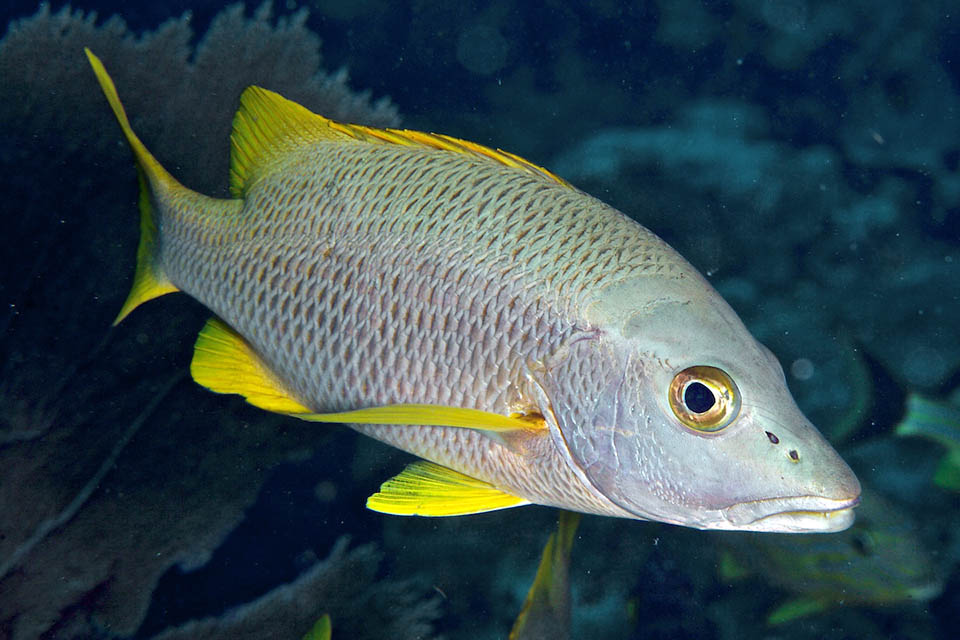
The Schoolmaster snapper (Lutjanus apodus) is an about 35 cm Caribbean fish living even 42 years, reaching 79 cm and 10,8 kg © Allison & Carlos Estape
The Schoolmaster snapper, Lutjanus apodus (Walbaum, 1792), known also as Schoolmaster or simply as Yellow snapper fish, zoologically is not a dentex, even if at first sight it looks like. Like all snappers it belongs the family of the Lutjanidae, the so called snapping fishes due to the showy canines and their voracity comparable to that of the real dentexes, like Dentex dentex, however taxonomically assigned to the family of the Sparidae.
The Lutjanidae, present in the tropical and subtropical seas of the whole world with 17 genera and 113 species, are however inserted together with the Sparidae in the suborder of the Percoidei, not to mention the predatory affinities and the fact that they are both groups important for the human nutrition.
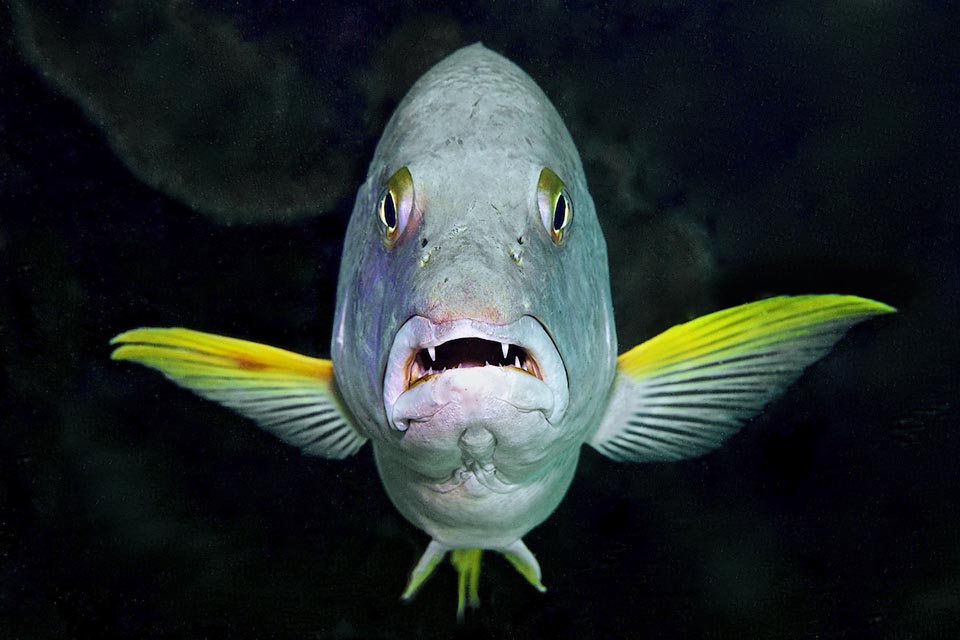
The mouth is large with two showy vampire-like canines up, smaller conical pointed teeth on the lower jaw and thick small teeth on the palate © Allison & Carlos Estape
The genus Lutjanus, created by Bloch in 1790 for Lutjanus lutjanus, boasts today about 70 species and originates from the name the Indonesian fishermen gave to this fish.
The specific term apodus, footless in Greek, assigned by the German naturalist and taxonomist Johann Julius Walbaum originates instead, oddly, from the mistake of an illustrator who had forgotten to draw its fins. Walbaum, who had not the animal at his disposal, described it in this way based on this image, naming it apodus due to the unusual absence of the pectorals, seen by him for the motor function like the feet of the fish.
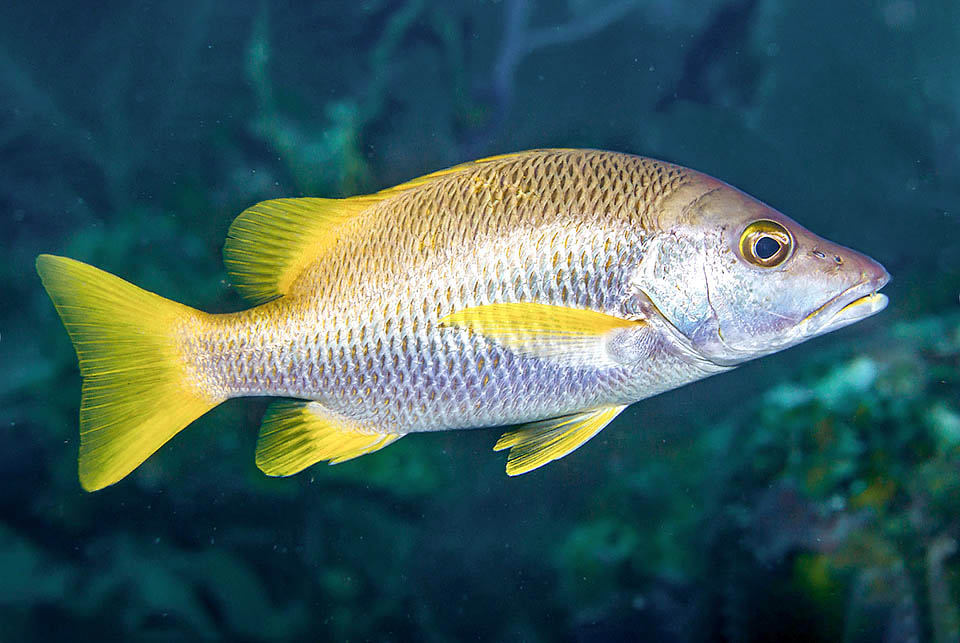
The fins are yellow and the body has golden hues like the American buses carrying the kids to school, hence maybe its odd common name © Allison & Carlos Estape
For what the unusual current name of schoolmaster is concerned, this might be a reference to the way they move in schools or maybe also for the fact that in the USA the buses carrying children to school are yellow painted.
Zoogeography
Lutjanus apodus is present in the western Atlantic, from Massachusetts, where, however, are found only young that generally do not survive the winter cold, to north of Brazil.
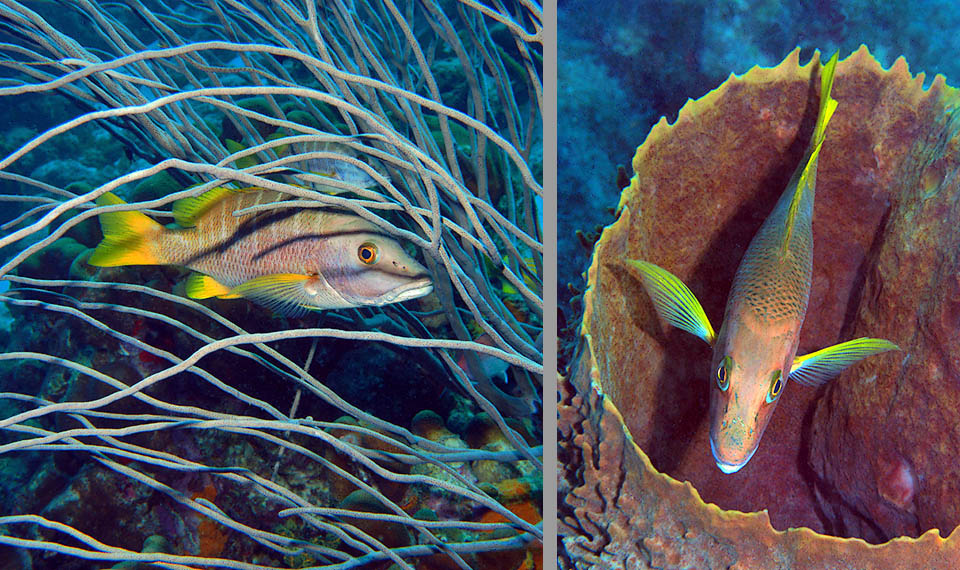
During the day often rests sheltered by coral ramifications, like Ellisella elongata, left, and even hidden inside big sponges like Xestospongia muta © Pauline Walsh Jacobson
It is common in the Caribbean Sea, especially in the West Indies and in the Dutch Antilles, abundant only on the cliffs of Mahahual and Quintana Roo in Mexico, but rare in north Florida.
Ecology-Habitat
The Schoolmaster snapper is found among the madreporic formations in relatively shallow waters, usually between 1 and 50 m of depth, with a record at 89 m.
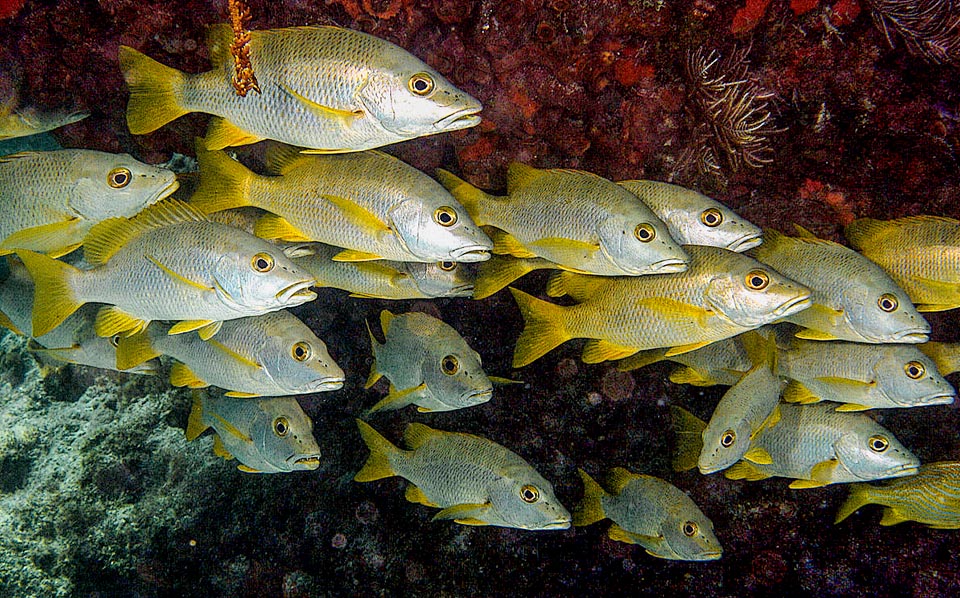
Spends most of the time swimming, sometimes in schools, looking for preys: chiefly crustaceans, but also fishes and cephalopods © Kevin Bryant
It’s a fish that goes hunting mainly during the night resting during the day in the shelter of coral formations of Acropora palmata, Ellisella elongata and also inside large sponges like Xestospongia muta, but can also can camouflage in schools in the submerged prairies of phanerogams.
It has been discovered that it rests only 3 hours per day, and spends the rest of its time swimming looking for food.
Conversely, the juveniles grow among the roots of the mangroves and at times also frequent the brackish waters hiding among the aquatic plants.
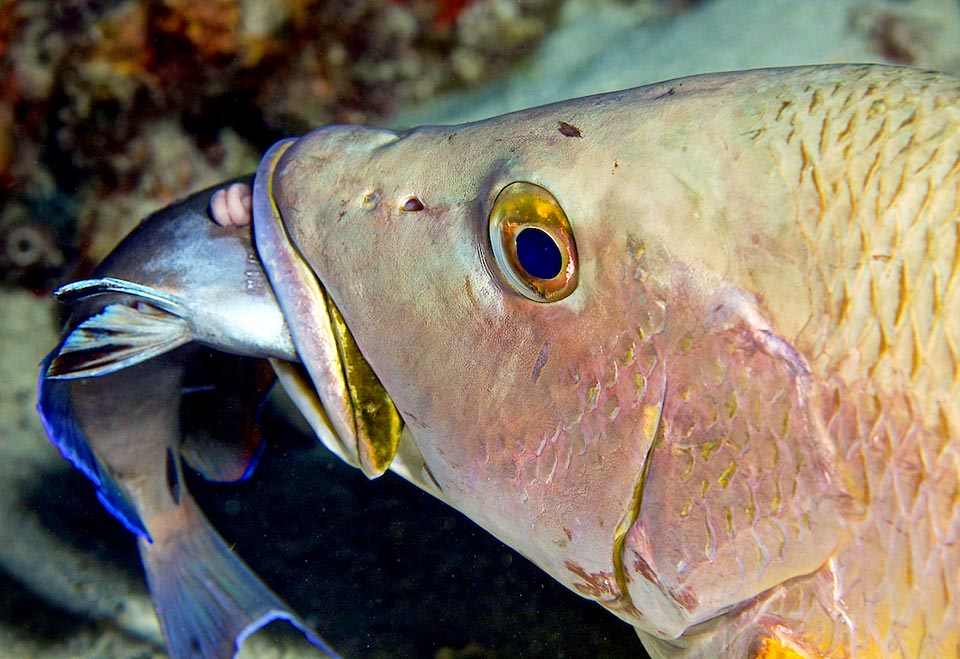
This has just seized an Acanthurus coeruleus, not at all worried by the sharp blade on the caudal peduncle of the surgeonfish © Allison & Carlos Estape
Morphophysiology
Lutjanus apodus can live even 42 years reaching the length of 79 cm with a published maximum weight of 10,8 kg, but the current size is of about 35 cm.
The body is relatively high and is compressed on the sides with a pointed snout, scaleless, and two holes as nostrils on the sides.
The large mouth has on the upper jaw; slightly protractile, two showy vampire-like canines, visible also when the mouth is closed.
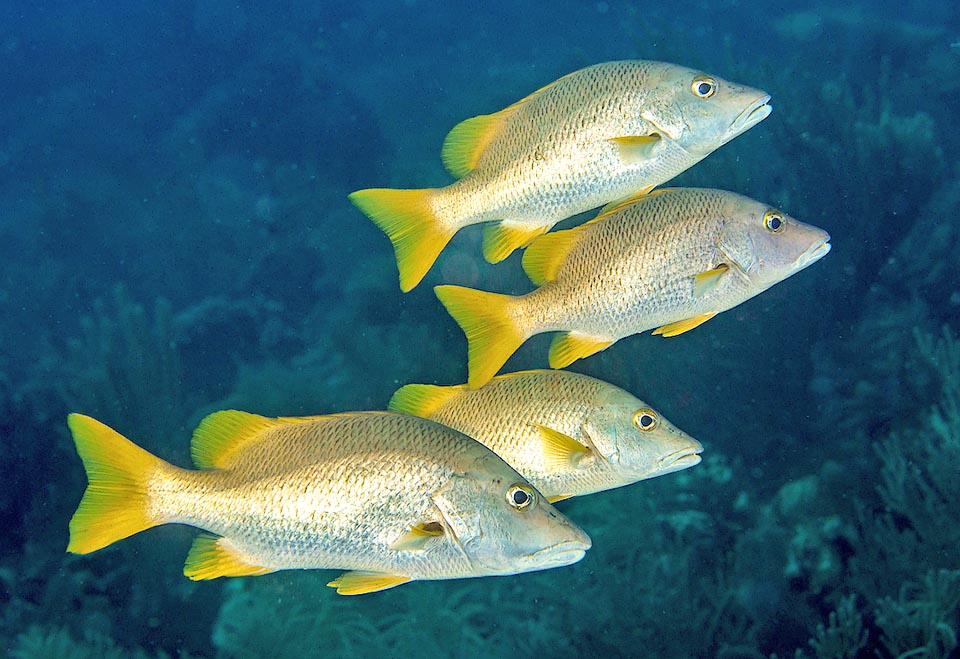
There are no reproductive aggregations. Couples take form and the eggs fecundated swimming lie unattended on the seabeds © Allison & Carlos Estape
The conical pointed teeth of the lower jaw are decidedly more modest, and on the palate we note, like in other Lutjanidae, some tiny close together teeth forming an anchor-shaped blob with elongated spindle.
The preoperculum is serrated with a toothed lower margin.
The dorsal fin has 10 spiny rays and 14 soft; the anal 3 spiny rays and 8 unarmed. The pectoral ones, pointed and unarmed as well as the pelvic count 16- 18 rays and reach almost the height of the anus. The caudal is slightly emarginate. The scales are present also on the cheeks and on the operculum.
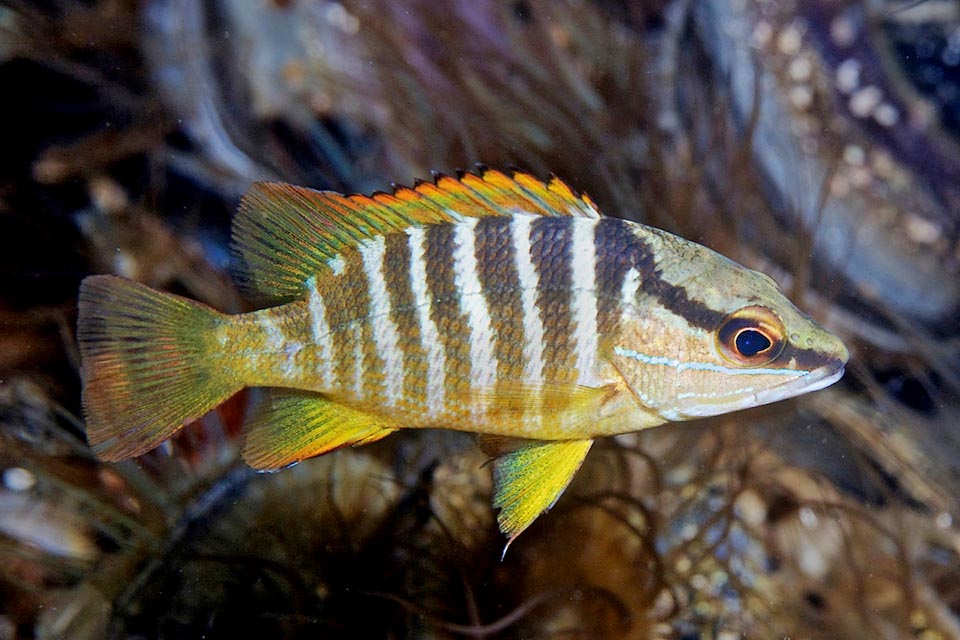
Juveniles have 8 dark vertical bars on the sides, similar to the diagonal crossing the eye, and below we note a thin horizontal blue line © Allison & Carlos Estape
The adults have yellow fins and the body, brownish olive grey on the back, is silvery on the sides, often with light golden orange reflections.
The juveniles’ livery is definitely different. They have on the sides 8 dark vertical bars similar to the diagonal that crosses the eye starting from the upper lip. Under this, horizontal, runs a thin blue line that reaches the tip of the operculum running along the base of the eye.
All these drawings disappear as the fish grows. The sexual maturity is reached in both sexes around the 25 cm of length when 1-2 years old.
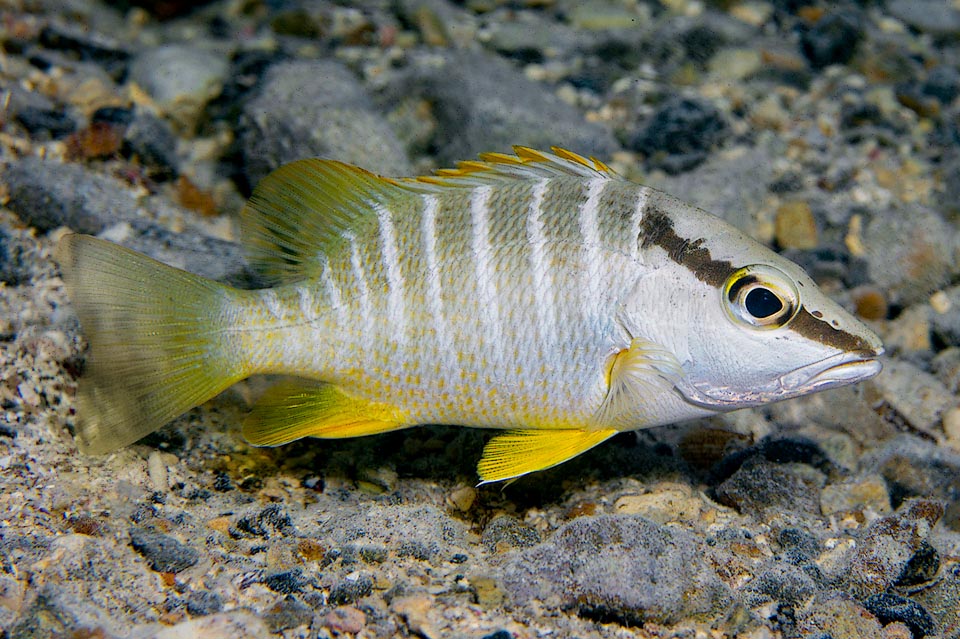
Growing the drawings fade and the last to disappear is the camouflaged diagonal hiding the eye © Allison & Carlos Estape
The blue line, broken into a light hatching, can be at times present also in the adults whilst the diagonal black bar of the eye disappears completely. The vertical bars lighten but may be present, greyish, also in the adults.
Ethology-Reproductive Biology
The juveniles of Lutjanus apodus initially nourish mostly of the tiny crabs of the genus Aratus, present only on the roots of the mangroves, whilst the subadults improve their diet with other species and worms they find in the submerged prairies. But when the mouth grows, the main dish, without forgetting the crustaceans, gets rich in fishes and cephalopods.
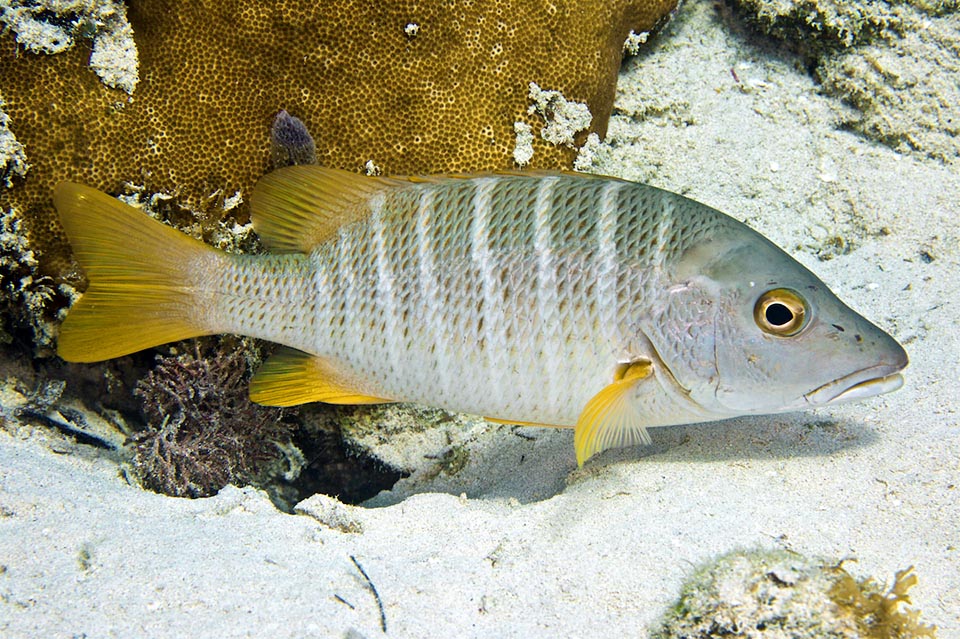
Growing the drawings fade and the last to disappear is the camouflaged diagonal hiding the eye © Allison & Carlos Estape
For Lutjanus apodus there are no reproductive aggregations. The eggs, fecundated while swimming between the currents, do not float as usually happens in the Lutjanidae but lie, unattended, on the seabeds. The resilience of the species is mediocre, as the minimum time necessary for the doubling of the populations is of 1,4-4,4 years and the fishing vulnerability, moderate, marks 37 on a scale of 100.
The Schoolmaster snapper, also fished for pleasure with the reel, is appreciated for its flesh and is often present on the local markets despite the risk of ciguatera, serious food poisoning theoretically possible in the biggest specimens that have been predating for years animals that store in their tissues the toxin produced by the dinoflagellate Gambierdiscus toxicus.
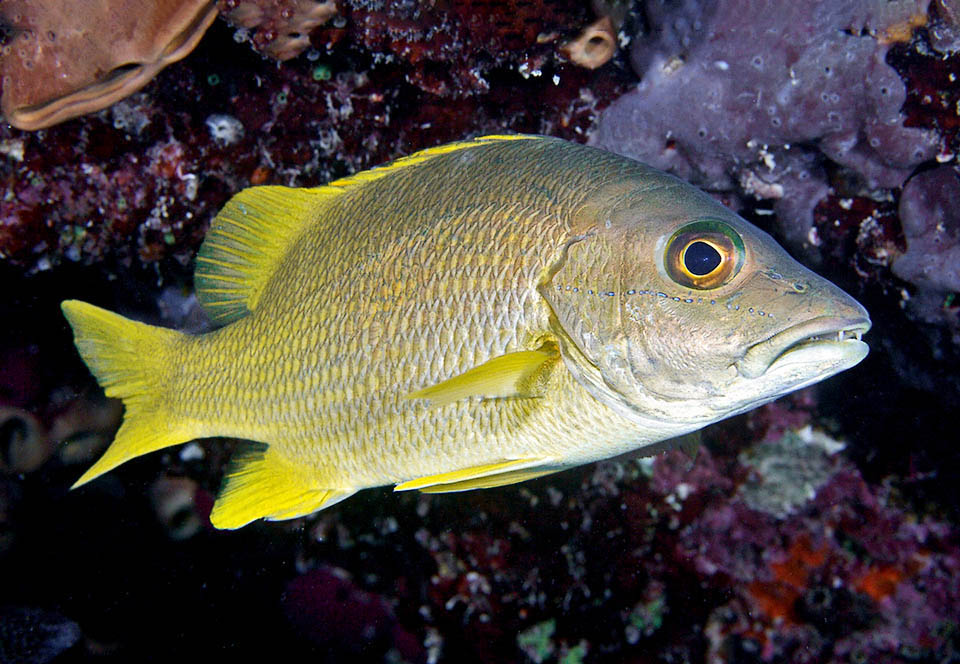
In the great adults that don’t forget their youth, at times we can glimpse, hatched, also the thin blue line up to the tip of the operculum © Allison & Carlos Estape
Lutjanus apodus in any case appears from 2015 as “LC, Least Concern” in the IUCN Red List of the endangered species.
Synonyms
Mesoprion canis Buettikofer, 1890; Perca apoda Walbaum, 1792; Neomaneis apodus (Walbaum, 1792), Sparus caxis Bloch & Schneider, 180; Lutjanus caxi (Bloch & Schneider, 1801); Mesoprion caxis (Bloch & Schneider, 1801); Bodianus striatus Bloch & Schneider, 1801; Bodianus fasciatus Bloch & Schneider, 1801; Holocentrus albostriatum Bloch & Schneider, 1801; Bodianus albostriatus (Bloch & Schneider, 1801); Lutjanus acutirostris Desmarest, 1823; Mesoprion cynodon Cuvier, 1828; Mesoprion linea Cuvier, 1828; Mesoprion flavescens Cuvier, 1828.
→ For general information about FISH please click here.
→ For general information about BONY FISH please click here
→ For general information about CARTILAGINOUS FISH please click here.
→ To appreciate the BIODIVERSITY of BONY FISH please click here.
→ To appreciate the BIODIVERSITY of CARTILAGINOUS FISH please click here.
